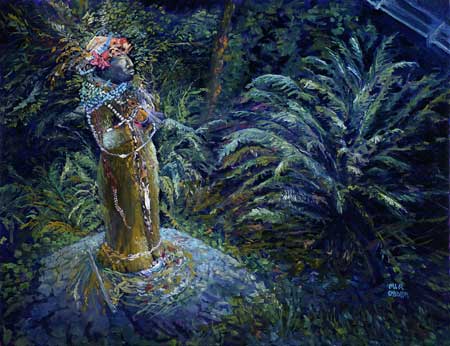Amanda

Friends -
This is my fifth painting for the Cape Perpetua Scenic Area; different from usual. In the interest of covering the essentials of Cape Perpetua Scenic Area, a painting of Amanda was needed. I will try to summarize why that is true here. To briefly give you some information about Amanda, below is an excerpt from "The Yachats Indians, Origins of the Yachats Name and the Prison Camp Years", by Joanne Kittel and Suzanne Curtis, 1996.
"The Alsea Sub-agency was in truth a prison camp.' .'from this account that we know about Amanda, a blind Coos woman who was the common law wife of a white man. They had a daughter, Julia. After the establishment of these reservations, soldiers had the right to remove native people to reservations, even if they had children, unless they had a legal marriage to white persons. This particular white man refused to marry Amanda. In 1864, Amanda was forcibly taken from her daughter and marched to Yachats. Beckham writes, "Little pity was given to Indians who escaped the Reservation. The Coos woman, Amanda, had a terrible time climbing around Cape Perpetua on the forced march in 1864. Bensell noted, 'Amanda who is blind, tore her feet horribly over these ragged rocks, leaving blood sufficient to track her by.
Thanks to great efforts from important individuals, a trail was created to commemorate a portion of the path just uphill from the one that Amanda was forced to follow. Of course, I had to take a part by hiking the 'Amanda Trail' myself. There is a sign at the Cape Perpetua Day Use Area to tell you the trail is there, but nothing to inform you of what you will find.
After some 2+ miles, I descended upon Amanda - waiting and watching, deep in the shadows of a high tree canopy, and surrounded by ferns, sorrel and green richness. To be true, it was a memorial statue. But it felt to me like Amanda.
It was hard not to think that she knew I was there. Did she see me? Well, no, she was blind. Did she move slightly? No, I think not. But why was she smiling, especially considering her suffering? Maybe she is happier now.
The only explanation for the smile on her face can be that now she is being honored - in sharp contrast to how she was treated in 1864. Now there is no soldier forcing her to move forward, no blood coming from her feet, and based on the decorative tribute of beads, feathers, shells and flowers, it is clear that she is often remembered and is valued. So, she smiles.
There is not much more that I can say. But go there some day and see for yourself.
margie lopez read
top